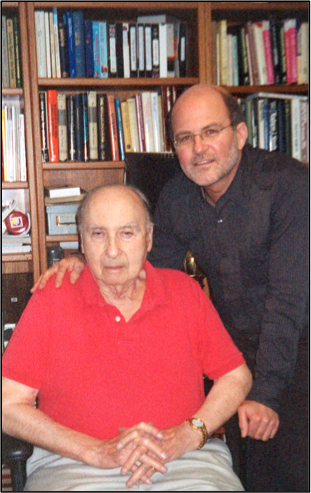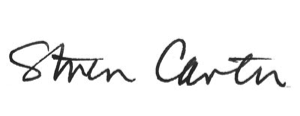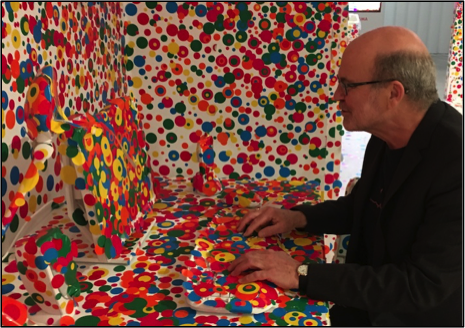With this issue, Managing Editor Steven Carter retires from the Journal of Orthomolecular Medicine
In June 1987, Abram Hoffer and his wife, Rose, traveled from Victoria to Vancouver, British Columbia, to spend an afternoon with me, to talk about the future of the Canadian Schizophrenia Foundation (CSF) and Orthomolecular Medicine, and to see if we would like to work together. The day slipped by as we became deeply engaged in conversation that grew richer by the hour. At that time, I was Editor of Alive Magazine and Books, and familiar with Hoffer’s work and the Journal of Orthomolecular Medicine. Abram and I both had an inkling that this meeting was to be one of the most significant in our lives.
Abram started this Journal as founding Editor in 1967, the year before the Canadian Schizophrenia Foundation was chartered. The Journal’s original title, Schizophrenia, was changed to the Journal of Orthomolecular Psychiatry in 1972, and to the Journal of Orthomolecular Medicine in 1986. Abram’s sister, Fannie, was the Journal’s first managing editor. Following Fannie’s death in 1978, her husband, Irwin Kahan (the CSF’s first executive director), assisted in the Journal’s publication until his retirement in 1986.
When Abram asked me to take on the roles of Executive Director of the CSF and Managing Editor of the Journal, the head office was in Regina, Saskatchewan. I accepted his invitation on the condition that we move the office to Vancouver, where I resided at the time. In 1987, there were few office computers, no Internet, no email; a donor provided an IBM electric typewriter and a fax machine to add to the small container of office furniture and archival material that I shipped out from Regina to our office above a credit union in Vancouver. My experience as a typesetter and graphic designer allowed us to produce the Journal in-house, where I assembled every issue on a light table, cutting and pasting copy sheets produced by a Comp/Set 500 phototypesetter. A small press printed the Journal locally. (It wasn’t until 1994, when desktop publishing was well established, and when Greg Schilhab joined our production team, that the Journal was first produced in digital format for printing.)
Abram and I spoke by phone several times a week in the first few months – we had some catching up to do, as almost six months had passed since the Journal had been published.
Publication Highlights
As a first task, to mark the 20th anniversary of the Journal in 1987, I asked Richard Kunin, a leading orthomolecular psychiatrist in San Francisco and member of the Editorial Board, to write an update on the scope and practice of orthomolecular medicine. Principles That Identify Orthomolecular Medicine was published in JOM Vol. 2, No.4.
The following year (1988), we inaugurated the Around the World column with reports from Gert Schuitemaker in Europe and Robert Buist in Australia. This column provided a forum to communicate the various international activities and progress in orthomolecular medicine. It sowed the seed for the International Society for Orthomolecular Medicine, later established in 1994.
In May 1988, with the intention of renewing awareness of the Journal, I attended the annual conference of the Huxley Institute for Biosocial Research (formerly the American Schizophrenia Association) in New York City, along with Abram and Rose Hoffer. There I was introduced to Carl Pfeiffer, Lendon Smith, and Harvey Ross, all editorial board members of the Journal at the time. It was particularly exciting to meet Carl Pfeiffer, who was instrumental, along with Abram, in pioneering orthomolecular psychiatry. Dr. Pfeiffer opened the Brain Bio Center in 1973, was an associate editor of the Journal of Orthomolecular Psychiatry and presented at the annual meetings of the Canadian Schizophrenia Foundation. In his memorial to Dr. Pfeiffer, who died in November 1988, Abram wrote: “I believe scientists like Carl Pfeiffer, Linus Pauling, Humphry Osmond, Emanuel Cheraskin, and many more, are characterized by a divine discontent which sets them apart from other scientists. They cannot be happy with what is known, especially when they know this is not enough. They are not content to practise what is merely common; for them, this is inadequate.”
In 1990 we published the first of two joint papers by Abram Hoffer and Linus Pauling examining the role of vitamin C in cancer patients. The second appeared in 1993. I met Linus Pauling at the Linus Pauling Institute in 1989, and invited him to present at our Conference in Vancouver in May 1990. When I picked up Dr. Pauling from the airport, he had no luggage, just an attaché case containing his papers, a clean shirt and underwear; “That’s all I need in my ninetieth year!” he declared. I introduced my mother to Dr. Pauling at a public talk he gave for 2,000 people at the Orpheum Theatre in Vancouver, noting that she would not heed my urgings to take vitamin C. “Listen to your son!” he admonished Mom, and she has been doing so, at least in taking vitamin C, for the last 28 years.
A milestone issue, Vol. 3/4, 1991, presented papers delivered at the Second World Vitamin C Congress, and included four articles from Linus Pauling and Matthias Rath on vitamin C and cardiovascular disease. The issue also introduced the long-running Case from the Center feature, provided by Hugh Riordan’s Center for the Improvement of Human Functioning in Wichita, Kansas (later to become The Riordan Clinic). From 1991 to 2010, this regular column presented over 80 cases; James Jackson, the BioCenter Laboratory Director, and Editorial Board member, was instrumental in keeping the cases coming.
Dr. Pauling died in his 94th year, just days before a major meeting of the Linus Pauling Institute of Science and Medicine in San Francisco in September 1994. Abram and I attended that conference, where the atmosphere was a mixture of the shock of loss and the celebration of a great man. In his memorial in the Journal Abram wrote, “As I listened to the various speakers, from about twenty universities from USA and around the world, it was amply clear that a meeting of this type could not have been held if Dr. Pauling had retired at age 65 when he first contemplated doing so.”
The entire volume of the Journal in 2001 was dedicated to Dr. Pauling’s centenary.
In 1999 we published a Special Schizophrenia Issue. From my introduction: “This issue is devoted to the diagnosis, prevention and treatment of schizophrenia. Following Dr. Hoffer’s current overview of schizophrenia diagnosis, we reprint four classic papers spanning the thirty years of our publishing history. We trust our readers will find them as interesting and relevant now as when they first appeared.”
A Special issue on vitamins was published in 2003, sponsored in part by the Canadian Health Food Association and distributed to over 5,000 health food stores in Canada. The issue featured articles on all the vitamins by several editorial board members, and Stephen Lawson’s excellent The Trials and Tribulations of Vitamin C.
Another Special Issue in 2004 provided an annotated bibliography of 44 studies on the effectiveness of vitamin C with chemotherapy in cancer treatment, and a review of other antioxidants used with chemotherapy and radiation in cancer treatment. We also inaugurated the Orthomolecular Medicine Hall of Fame in 2004.
We celebrated the 40th Anniversary of Orthomolecular Medicine in 2008 with great articles by Stephen Lawson and Steve Hickey.
Fondly Remembered Editorial Board Members
Emanuel Cheraskin (1916 – 2001), regular contributor to the Journal and presenter at many annual conferences, was among the first to understand and promote the fact that oral health indicates whole body health. His final paper on homeostasis, published after his death, stressed the importance of health education, an endeavour to which he had dedicated his life. Dr. Cheraskin took up painting in his last decade, and sent me a small canvas entitled “Fast Forward,” an indication of how he lived.
Hugh Riordan (1932 – 2005) was the founder of the Center for the Improvement of Human Functioning in Wichita, Kansas (later, The Riordan Clinic). In addition to the previously mentioned Case from The Center regular feature, Hugh contributed many other articles. A major donation from the dissolved Princeton Brain BioCenter in 2002, along with Hugh’s determination, enabled us to scan and digitize all issues of the Journal from 1967 to 1994. This free searchable archive has been a valuable resource to readers and researchers worldwide. From 1995 to 2005 Hugh and I met annually to spend a day or so exploring ideas for the growth of the Journal. These brainstorming sessions often involved some fine dining and attending a ballet or other concert performance.
Harold Foster (1943 – 2009), geographer extraordinaire, contributed dozens of articles relating soil mineral content to disease distribution, focusing on selenium’s role in cancer, AIDS and schizophrenia. Harry was a well-respected lecturer at the Orthomolecular Medicine Today Conference. During a special lunchtime program in 2004 we announced Harry as the Orthomolecular Medicine Doctor of the year, but Harry could not be found. We later learned he had slipped out to make a bet on the Kentucky Derby running the same day; Harry’s passion for horse racing took precedence over orthomolecular medicine on that occasion. After Abram’s death on May 27th, 2009, Harry agreed to take over the Journal editorship, but he died less than three months later on August 15th.
Erik Paterson (1941- 2016) contributed regularly to the Journal from 1985 and served on editorial board since 1995. In addition to dozens of useful case reports from his general practice, we published a few of Erik’s speculative papers including “Orthomolecular Medicine in the Universe.” At all formal functions, such as the Orthomolecular Medicine Hall of Fame and the 2007 Tribute Gala honouring Abram Hoffer’s 90th year, Erik appeared in the Paterson tartan kilt, to the delight of all the guests. Erik was himself inducted into the Hall of Fame in 2011.
Other notable members of the editorial board with whom I worked include: Bernard Rimland (1928 – 2006); David Horrobin (1939 – 2003); Lendon Smith (1921 – 2001); Max Vogel (1915 – 2002), and Richard Huemer.
 Abram Hoffer, Friend, Colleague, Inspiration
Abram Hoffer, Friend, Colleague, Inspiration
Of all the relationships that I am grateful to have enjoyed with the people who served on the Journal board, the most important has been my friendship with Abram Hoffer. The excitement and surge of ideas at our first meeting was an indication of how we would continue. In 1987, I thought I’d made a five-year commitment; 30 years later, I know that Abram’s inspiring courage, integrity, humanity and intelligence were factors in my perseverance. We worked closely together on every issue of the Journal, planned the programs for the Orthomolecular Medicine Today Conferences, and developed a vision for the expansion of the International Society for Orthomolecular Medicine, all while he was also running his busy private practice and I was serving as Executive Director of the International Schizophrenia Foundation.
I visited Victoria often as our friendship grew. Abram and Rose came to know my children, and I later became friends with their daughter, Miriam, in Toronto, and son, John, in Montreal.
With Abram at his home office in 2006
After Abram stepped down from the board of the International Schizophrenia Foundation and no longer attended the Orthomolecular Medicine Today Conference, he continued as Editor of the Journal, and remained enthusiastic about everything we published. His last paper, aptly titled “Orthomolecular Treatment for Schizophrenia,” presents a simple case report and asks why, after 50 years, few doctors embrace the orthomolecular approach. He also suggests, now that the Journal is available online, “Perhaps it is time to say goodbye to Medline.”Following Abram’s death in 2009, we published a special commemorative double issue presenting 20 pages of tributes to Abram from around the world.
With the passing of Abram in May, and Harry Foster in August 2009, we were fortunate to have Jonathan Prousky agree to take on the role of Editor. Jonathan had studied and worked with Abram in his Victoria practice, had excellent writing, research and editing skills, and shared Abram’s passion for orthomolecular medicine, niacin and schizophrenia. Jonathan was the first naturopathic doctor on the editorial board. (Abram had been awarded an Honorary Doctor of Natural Medicine by the Canadian College of Naturopathic Medicine in 1993.) Under Jonathan’s editorship from 2010 to 2017, the Journal underwent many substantial production changes and became more rigorous in its peer review process. His commitment to the Journal, while serving as Chief Medical Officer at CCNM, was exemplary. It was always a pleasure to work with Jonathan, who is consistent, clear, meticulous, and sticks to deadlines. He and I also share an appreciation for the antioxidant properties of red wine.
The Journal Today
I have appreciated the support and engagement of all the current members of the JOM editorial board:
- Alex Schauss (Tucson, AZ) editorial board member since 1988, Associate Editor since 2010. focusing on the effects of diet on behavior. Orthomolecular Medicine Hall of Fame 2014
- John Hoffer (Montreal, QC) editorial board member since 2007, Associate Editor since 2010. John facilitated the publication of a special issue “Proceedings from the Vitamin C and Cancer Workshop, Montreal, May 31 and June 1, 1999.” Orthomolecular Medicine Hall of Fame 2015
- Aileen Burford Mason (Toronto, ON) editorial board member since 2007. (“Magnesium, anyone?”) Orthomolecular Medicine Hall of Fame 2015
- James Greenblatt (Boston, MA) editorial board member since 2018. Orthomolecular Medicine Hall of Fame 2017
- Michael Gonzalez (San Juan, PR) editorial board member since 2000. Cofounder of the RECNAC Project and prolific author on vitamin C and cancer. Orthomolecular Medicine Hall of Fame 2016
- Steve Hickey (Manchester, UK) editorial board member since 2005. Contributor of several valuable papers on vitamin C.
- Ron Hunninghake (Wichita, KS) editorial board member since 2006. Exceptional doctor and teacher, Medical Director of the Riordan Clinic and contributor of many Cases from the Center. Orthomolecular Medicine Hall of Fame 2013
- Bo Jonsson (Stockholm, Sweden) editorial board member since 2007. Bo is the founding Chairman of the Swedish Society for Orthomolecular Medicine and has attended the Orthomolecular Medicine Today Conference for the past 13 years.
- Laurie Mischley (Seattle, WA) editorial board member since 2018. Specialty in Parkinson’s disease.
- Todd Penberthy (Orlando, FL) editorial board member since 2010.
- Andrew Saul (Brockport, NY) editorial board member since 2003, assistant editor 2006 – 2010. Editor-in-Chief of the Orthomolecular Medicine News Service. Orthomolecular Medicine Hall of Fame 2013
- Gert Schuitemaker (Gendrigen, The Netherlands) editorial board member since 1994. Publisher and Editor of the Dutch language magazine Orthomoleculaire since 1983. Orthomolecular Medicine Hall of Fame 2011
I’m very appreciative of Greg Schilhab, the Journal’s production manager and editorial assistant for over two decades. Greg joined us after we moved the Journal office from Vancouver to Toronto in 1992. His longstanding commitment and creative service proved Greg to be a true friend of orthomolecular medicine. The Orthomolecular Medicine Today Conference photographs published in the Journal come from Greg’s camera. He guided us from the early days of digital production through to our first online publication, pulling innumerable all-nighters to meet deadlines.
Since 2017, Andrew Cuscianna has been ably managing the Journal’s online production. Andrew was responsible for our transition to Open Access and bimonthly publication.
Taking My Leave
As I write this, the 47th Annual International Orthomolecular Medicine Today Conference is taking place for the first time outside of Canada in Tokyo, Japan. Of all the international growth of Orthomolecular Medicine, Japan’s has been exceptionally strong, thanks to pioneers Masatoshi Kaneko, Tsuyoshi (Ken) Kitahara, Hiroyuki Abe, and the current ISOM President, Atsuo Yanagisawa, all members of the Orthomolecular Medicine Hall of Fame. The excitement of this expansion is reflected in the Conference’s large delegation of 800 people.
With this brief overview of my thirty years as the Journal’s managing editor, I’ve intended to offer some sense of the personal aspect of my involvement and of my regard for the many wonderful people with whom I have worked. Together we have published a vast body of editorials, clinical reports, original research, reviews, educational papers and essays. To have reached the 50th anniversary of the Journal in 2017, and the 50th anniversary of Orthomolecular Medicine this year, constitute a major achievement. With the move to Open Access, the Journal has increased its reach and readership. In retiring now, I leave behind half of my life and continue in gratitude and assurance that the work we have published in this Journal has benefited thousands and will benefit thousands more in the years to come.
With best wishes and in good health,


After 30 years editing the Journal, ORTHOMOLECULES take over!


